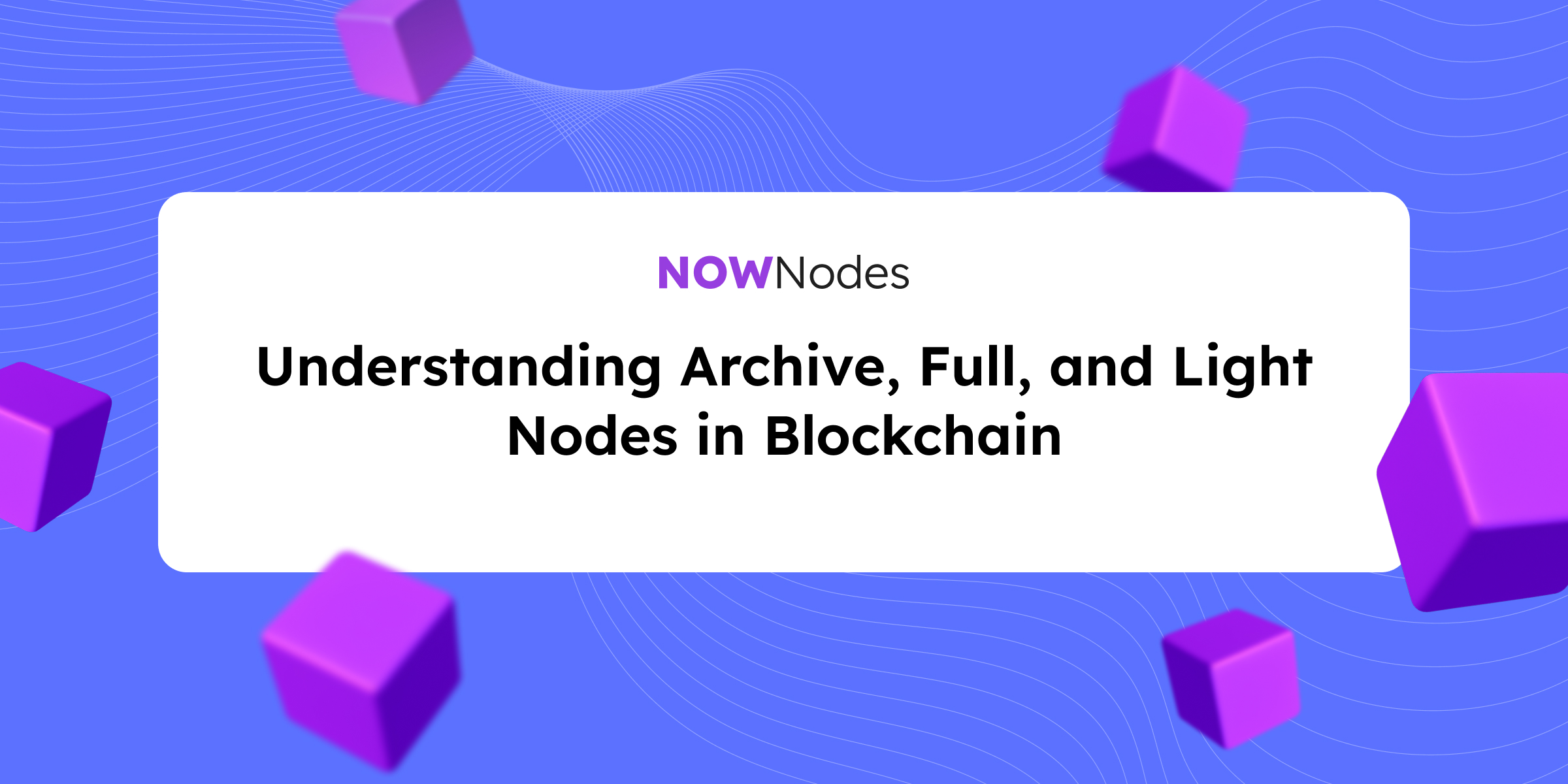At NOWNodes, we often receive questions from developers and enterprises about which node type best fits their blockchain use case. There are three types of node — archive, full, and light — and the choice affects scalability, performance, disk space, and infrastructure costs.
Each type plays a distinct role in block validation, data storage, and maintaining the history of blockchain states. Understanding these differences helps you decide whether running a node or using a blockchain node provider that offers multiple connection options is the better choice for your Web3 project.
Comparison Table: Archive, Full and Light Nodes
| Feature | Archive Node | Full Node | Light Node |
|---|---|---|---|
| Data Stored | Entire blockchain with all historical states | Entire chain without historical states | Block headers only |
| Validation | Verifies transactions and states | Verifies transactions | Relies on full/archive nodes |
| Query Capabilities | Can answer any historical query | Tracks only the current state | Limited – depends on other nodes |
Archive Nodes
An archive node contains everything a full node does, plus complete historical blockchain information. This allows it to reconstruct any wallet balance or smart contract storage at any block in history. In other words, archive nodes retain the entire history of the blockchain and can provide a detailed view of the state of the network at any point in time.
However, running an archive node requires significant resources because node set up is complex and demands powerful hardware. It consumes a large amount of disk space and takes longer to reach full synchronization. Note that archive nodes aren’t suitable for every project — they are best for those that require extensive analytics or regulatory tracking.
You don’t necessarily need to run your own archive node. Instead, you can connect to a blockchain node provider that offers archive node access — like NOWNodes. This approach lets you access deep blockchain information without maintaining expensive infrastructure, depending on the client requirements.
Full Nodes
Full nodes maintain the backbone of blockchain networks. They store a copy of blockchain data from the genesis block and verify every transaction according to consensus rules. Full node store all blocks and transactions but do not preserve full historical states.
Unlike full nodes, archive nodes can access previous snapshots of the chain, while full nodes retain only the most recent state. Information that a full node can provide is limited to the current state, though it fully participates in block validation.
Because they balance performance, decentralization, and cost, full nodes are ideal for developers, wallets, and enterprises looking to decentralize their infrastructure without heavy storage needs. They are the most common choice among node clients who value reliability and security without excess data overhead.
In essence, a full node is perfect when your project needs nodes for data integrity and validation but not extensive history. Full nodes ensure accurate synchronization and provide real-time insight into the state of the network.
Light Nodes
Light nodes rely on full or archive nodes for verification and download only block headers. This design minimizes resource consumption and allows them to run efficiently on mobile devices or lightweight clients.
Light nodes are crucial for Web3 wallets and decentralized applications that need fast synchronization and low latency. However, since light nodes do not fully validate the chain, they depend on other nodes for blockchain information and cannot independently participate in block validation.
Because light nodes rely on others for trust, their performance may vary depending on the client configuration and available connections. Still, they play an essential role in helping users interact with the network easily and securely.
Choosing the Archive, Full and Light nodes
The best choice depends on your goals and available resources because node set up complexity and infrastructure needs vary:
- Archive Node – for analytics, explorers, and services that need access to the entire history of the blockchain.
- Full Node – for decentralization and network security with balanced storage.
- Light Node – for lightweight apps and wallets focused on speed and efficiency.
In the Web3 ecosystem, these three types of node serve different layers of functionality. Running your own node may give you full control, but it’s often more efficient to rely on a blockchain node provider that offers scalable access to multiple node types, including Ethereum node connections and other popular networks.
At NOWNodes, you can access full nodes via API across more than 110 blockchains — without the need to run and maintain your own infrastructure. Our service provides stable synchronization, fast responses, and access to verified blockchain information. If you need an access to archival nodes you can reach out our sales team and make a request.
Conclusion
Archive, full, and light nodes differ in how they store data, validate transactions, and access the current or historical blockchain state. Each has its role: archive nodes offer deep insight, full nodes maintain security, and light nodes provide accessibility.
Together, these nodes retain the balance between decentralization, speed, and transparency. Whether you’re building on Ethereum node infrastructure or any other blockchain, choosing the right setup ensures efficiency and scalability.
With NOWNodes, you get reliable nodes for data access and analysis — allowing your project to grow in the Web3 ecosystem while we handle uptime, scaling, and maintenance.



